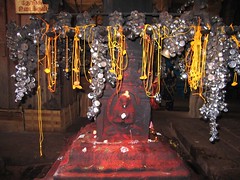Favorite quote from a filmmaker.
To be or not to be. That’s not really a question.
Jean-Luc Godard.
A good movie from a bad director.
A Star Is Burns (1995) by Señor Spielbergo. Although his non-union Mexican counterpart is actually not as bad as Mr Spielberg or his movies. (And, yes, I know that Señor Spielbergo is a fictional character in an animated sitcom.)
Favorite Laurence Olivier performance.
Dr Christian Szell in The Marathon Man (1976). He was also good in Last Action Hero as Hamlet.
Describe a famous location from a movie that you have visited. (Bodega Bay, California, where the action in The Birds took place, for example.) Was it anything like the way it was in the film? Why or why not?
I spent a pleasant afternoon under a bridge in the Los Angeles River culvert discussing Repo Man (1984) with Dean Lent. We also dropped by the Bradbury Building from Blade Runner (1982), but it was closed. Both of these locations were a lot like they were in their respective movies.
Carlo Ponti or Dino De Laurentiis (Producer)?
Ponti. If only because he produced Le Mépris, and Godard is said to have punched him in the face over the dubbing.
Best movie about baseball.
That’s a tough one, because I don’t much care for baseball. I’d have to say Damn Yankees (1958). Those outfielders sure could dance.
Favorite Barbara Stanwyck performance.
Sugarpuss O’Shea in Ball of Fire (1941).
Fast Times at Ridgemont High or Dazed and Confused?
Dazed and Confused (1993). It seemed closer to my experience in high school in the ’70s.
What was the last movie you saw, and why? (We’ve used this one before, but your answer is presumably always going to be different, so ...)
Diva (1981). Because it appeared in the mail; I got the DVD from Netflix. It was nice to see it again in widescreen and transfered from a decent print.
Whether or not you have actually procreated or not, is there a movie you can think of that seriously affected the way you think about having kids of your own?
Lumière’s L’Arroseur arrosé (1895) or Vigo’s Zéro de conduite: jeunes diables au collège (1933). I was going to say Man Getting Hit By Football (1995) by Hans Moleman or its subsequent remake with George C. Scott in the titular rôle, but I decided one pretend movie per film quiz.
Favorite Katharine Hepburn performance.
Eleanor of Aquitaine in The Lion in Winter (1968).
A bad movie from a good director.
Star 80 (1983) from Bob Fosse.
Salò: The 120 Days of Sodom—yes or no?
Yes. What is there not to like? Pasolini (his last film) and de Sade (wrote it while in the Bastille) together at last.
Ben Hecht or Billy Wilder (Screenwriter)?
Wilder, if only just slightly because he was also a director.
Name the film festival you’d most want to attend, or your favorite festival that you actually have attended.
I’d like to attend La Mostra Internazionale d’Arte Cinematografica di Venezia.
Head or 200 Motels?
The Blackadder episode Head. No, but seriously. The Monkees or Frank Zappa. I’ve seen both and liked them both.
Favorite cameo appearance. (This question was inspired by Daniel Johnson at Film Babble.)
Jean Eustache as a kind man with a bandage in a Parisian bar in Der Amerikanische Freund. Runners-up in the same film, Nick Ray (as a dead painter making a living) and Sam Fuller (as a mafia porn producer).
Favorite Rosalind Russell performance.
As Mame in Auntie Mame (1958).
What movie, either currently available on DVD or not, has never received the splashy collector’s edition treatment you think it deserves? What would such an edition include?
The Great Gabbo (1929, with screenplay by Ben Hecht, (can I change my answer above?). There is a DVD out there, but the famous multicolor sequences are in balck and white. It would have to include commentary by Stroheim and Hecht being channeled from beyond the grave. Also, a making of featurette would be nice. Anybody but Spielberg could direct it. If all that is not possible, the Simpsons episode Krusty Gets Kancelled could be bundled with it.
Name a performance that everyone needs to be reminded of, for whatever reason.
George Hamilton or Sophia Coppola in The Godfather, Part III (1990). Take your pick.
Louis B. Mayer or Harry Cohn (Studio Head)?
Barney Balaban at Paramount. For what he did to Max Flesicher. And for being Bob’s uncle.
Favorite John Wayne performance.
The Centurion at the foot of the cross (or Longinus) in The Greatest Story Ever Told (1965).
Naked Lunch or Barton Fink?
Is this the Head or 200 Motels question with different movies? Both are flawed great movies. I’d suggest two substitutions: have John Mahoney play Bill Lee and Ian Holm play Mayhew.
Your Ray Harryhausen movie of choice.
Valley of Gwangi (1969). It’s Jurassic Park without the CGI or the Spielberg.
Is there a movie you can think of that you feel like the world would be better off without, one that should have never been made?
E.T. the Extra-Terrestrial (1982) or Hook (1991).
Favorite Dub Taylor performance.
As Rev. Wainscoat in The Wild Bunch (1969).
If you had the choice of seeing three final movies, to go with your three last meals, before shuffling off this mortal coil, what would they be?
Cammell and Roeg’s Performance (1970), Fosse’s All That Jazz (1979), and Guest’s The Big Picture (1989).
And what movie theater would you choose to see them in?
The Alhambra in San Francisco, California.
Your proposed entry in the Atheist Film Festival.
Mel Gibson’s Passion of the Christ (2004). If atheists had not existed before that movie, they would have to after it.
What advice on day-to-day living have you learned from the movies?
Make ’em laugh!



